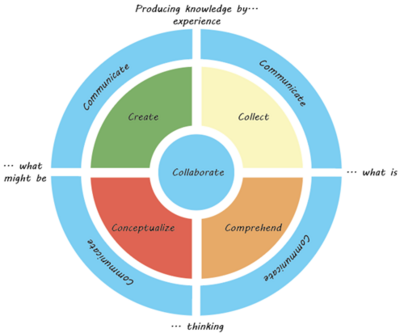The 6C Model
Contents |
Abstract
During a design process, knowledge is produced in many ways, especially in multidisciplinary teams where several approaches are implemented to drive innovation, sustainability, and functionality. Non-design fields are increasingly influencing the traditional deign methods, including sketching, prototyping, planning and development. [1] To facilitate a holistic approach, a designer must have an understanding of how knowledge is produced and sombine/integrate diverse fields to ensure shared understanding.
To help expand the designer's understanding the 6C Model has been developed, which describes six types of knowledge production in a design process. The model is designed to help the team members actively observe and become aware of different approaches when designing, and help translating knowledge into practical approaches. Together with a collection of co-creation cards, the method helps translating knowledge into practical approaches (Friis, S.A.K.) [2]. The model takes the design process through fours stages: Collect, Comprehend, Conceptualize and Create, not necessarily in that order. This is held together using collaborative tools and continuous communication.
The term knowledge production is referring to everything shared, used or implemented in the design process, which may contribute to a project. The method combines theory of cross-functional teamwork and understanding of design process, similar to the 3 Cs[3] and the Double Diamond[4], respectively.
This article will explain the 6C Model and its comparison to similar models. Finally, benefits and limitations using this model will be discussed.
Introduction
Background
The 6C Model was originally developed by Friis and Gelting in 2016, with a focus on integrating co-creative design methods into everyday design practices. The model is a developed version of the 5C Model by the same creators[2]. It is a framework to facilitate the design process through observation, understanding and then conscious acting on diverse approaches of designing. The method aims to accommodate collaborations across different disciplines and cultures and expand design principles into new areas of application (Friis, S.A.K, Section 3.2).
Elements in the 6C Model
The model is structured around four stages of the design process: Collect, Comprehend, Conceptualize, and Create. Together with Collaborate and Communicate the model has six categories involving different types of knowledge production. The vertical axis in the model is a scale with opposite modes on each side: By experience or thinking, including some sort of subjective mental processing. The horizontal axis is relating to the orientation and focus of the production of knowledge, considering whether it is produced about an existing situation, so what is, or a future situation asking what might be (Friis, S.A.K, Section 3.2).
Co-creation Cards
As an extra toolbox the Model includes a collection of co-creation cards, which are designed to help translating understanding and knowledge into complex problem solving and design progress. The cards help the team investigating the situation and provides a shared language.
6C Model
Subsection
Discussion
Example of how it is used in a project
Section 5.3 and 5.4 in (Friis, S.A.K.)
Limitations
Conclusion
Annotated Bibliography
Books:
Kjær, L.B. & Eskholm, L. &, Tøstesen, T. & Lagoni, T., Gain Power - An empowering tool kit for designers to understand Business & Organisational Context [5]. First edition, first printing 2017, Published by Design School Kolding, ISBN: 978-87-93416-22-2
- The booklet describes the 6C Model related to Design Thinking and Sustainability
Articles and Web-pages:
Friis, S.A.K. (2016), The 6C Model: The Contribution of Design to Open, Complex, Problem Solving [6]. The International Journal of Design in Society; Rome Vol. 10, Iss. 3, 13-30. DOI:10.18848/2325-1328/CGP/v10i03/13-30
- Description...
References
- ↑ [https://adk.elsevierpure.com/en/publications/the-5c-model] The 5C Model, Last visited 12-02-2023
- ↑ 2.0 2.1 [https://www.designskolenkolding.dk/sites/default/files/publication/download/gainpower_booklet._ex.cover_print_a3_bothsides.pdf] Gain Power - An empowering tool kit for designers to understand Business & Organisational Context, Last visited 12-02-2023
- ↑ [https://www.intercom.com/blog/the-3-cs-of-cross-functional-teamwork] Communication, collaboration, coordination: The 3 Cs guiding successful cross-functional teams, Last visited 12-02-2023
- ↑ [https://www.teknologisk.dk/design-thinking/metoder-og-vaerktoejer/37321,3] Design Thinking - Metoder og værktøjer, Last visited 12-02-2023
- ↑ Kjær, L.B. & Eskholm, L. &, Tøstesen, T. & Lagoni, T. (2017). Gain Power - An empowering tool kit for designers to understand Business & Organisational Context, Available Online
- ↑ Friis, S.A.K. (2016). The 6C Model: The Contribution of Design to Open, Complex, Problem Solving, Available Online
